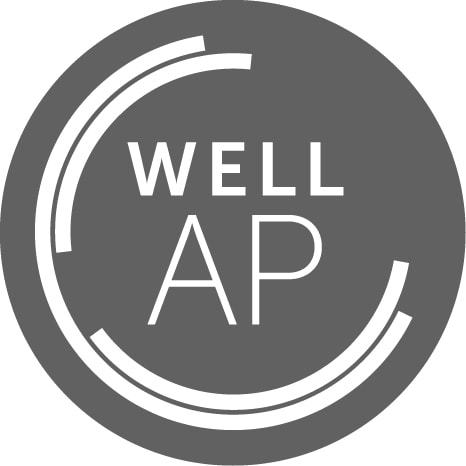COVID-19 changed the world as we know it, and how people live safely in it. This is especially true regarding the design priorities of commercial buildings and people’s perception of them. During the pandemic, many people were tasked with learning how to work from home. As the pandemic ebbed, and people began to come back to commercial office spaces, the office conditions needed to be viewed from a different lens. These spaces needed to be seen as safe and healthy. So it's no mere coincidence that the WELL Building Standard, which focuses on human health and well-being in building spaces, has seen a meteoric rise in the past few years. This course focuses on cutting-edge, human health-centered design priorities for commercial buildings, from lighting to living walls and floor coverings to restrooms, and how pursuing certification in the WELL standard offers guidance and provides third-party verification. This course follows the renovation of a commercial space whose officers used WELL Certification to create what one said was "the healthiest office in the country." A series of short videos highlight products and offer a tour of strategies the company used toward WELL certification.
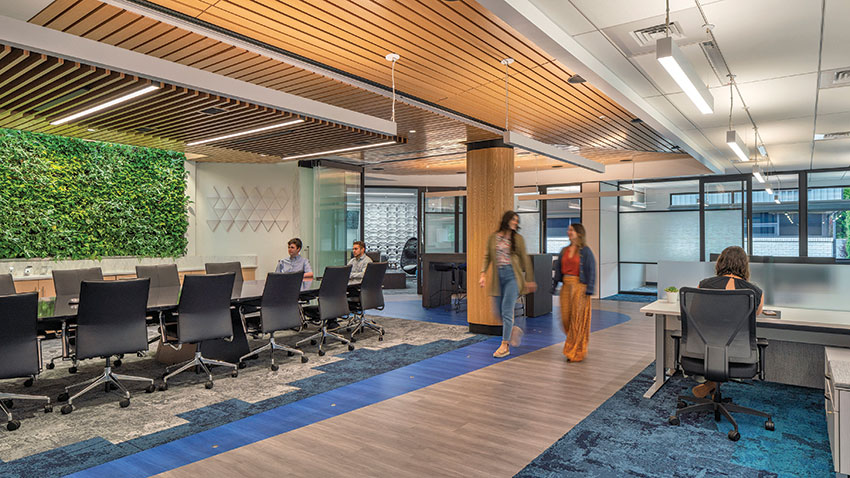
Photo: William Horne; courtesy of Excel Dryer
The double-sided living wall behind the reception area and in the conference room is a favorite feature among employees.
HOW COVID TRANSFORMED COMMERCIAL BUILDING DESIGN PRIORITIES
The ascent and decline of the COVID-19 pandemic profoundly altered societal views toward hygiene. While scientists warned for years that a virus could cause a worldwide tragedy, it wasn't until COVID-19's emergence that the danger of pandemics—both current and future—became real. The measures taken to prevent the spread of the virus included avoiding crowds, working from home, wearing masks, and increasing proper hand hygiene. While authorities suspended most such measures after the pandemic was declared over, the focus on hand hygiene emerged as a critical practice to continue.
According to the U.S. Centers for Disease Control and Prevention (CDC)1, “Clean Hands Save Lives” and handwashing is one of the best ways to prevent the spread of disease, which includes proper washing with soap and thoroughly drying by using a hand dryer or drying with a clean towel. Drying hands is an essential part of the process. The transmission of bacteria is 1,000 times more likely to occur from wet skin than from dry skin; therefore, the proper drying of hands after washing should be an integral part of the hand hygiene process in health care.2
At the end of the pandemic, companies welcomed employees—who had been working from home for safety reasons—back into the office. But employees wondered: Are these spaces safe to be in? Are they healthy? Is the air clean? Is it sanitary? Will being at work make me sick, or will it make me healthy?
One Company That Prioritized Employee Health and Wellness in its Office Expansion: The issues of workplace safety and employee well-being were paramount for a global manufacturing company in western Massachusetts working on a major addition and renovation to its existing headquarters' office space. "Creating a space post-pandemic, we definitely wanted to focus on the health and wellness of our employees," said William J. Gagnon, Executive Vice President and Chief Operating Officer of Excel Dryer, a family-owned company.
Excel Dryer was already in tune with hand hygiene and other safety strategies as a leading manufacturer of high-speed, high-efficiency hand dryers. Expanding that care to all parts of the project was a natural progression. "My goals were simple," Gagnon said, "to create the most beautiful, sustainable, and healthy workspace possible. It is easy to say, but not easy to accomplish. So I really challenged the architects and designers to focus on innovation and leading-edge technologies in all areas."
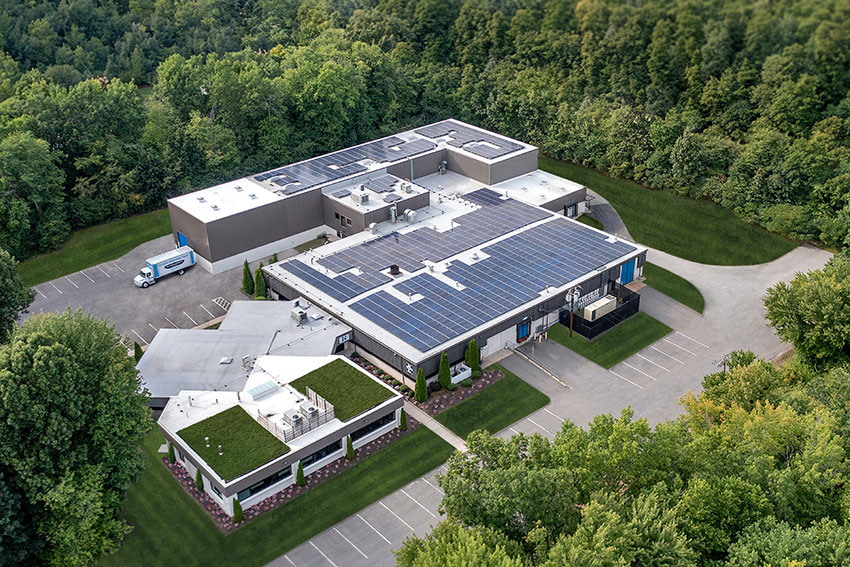
Photo courtesy of Excel Dryer
The addition and renovation includes a living roof and photovoltaics.
Toward the goal of a healthy office space, Gagnon began working with architect Katherine Brekka, AIA, LEED AP, WELL AP, Senior Associate with Fennick McCredie Architecture in Boston. "Our major priority on this project," Brekka explained, "was to ensure we were employing design strategies to promote the health and wellness of the occupants as much as possible."
She said, "We want people to be excited to come to work." From the beginning, Gagnon targeted WELL certification. His goal was for the design to reach the latest international standards for health and wellness, which led the team to the International WELL Building Institute (IWBI) and the WELL Building Standard.
HOW THE WELL BUILDING STANDARD HELPS CREATE HEALTHIER BUILDINGS
The WELL Building Standard focuses on the health and well-being of occupants. While WELL is newer and less known than the LEED, Energy Star, and BREEAM rating systems, it is growing exponentially. Today, the WELL Building Standard is being applied in more than 40,000 buildings in some 124 countries and encompassing more than 4.7 billion square feet of real estate around the globe.
According to the WELL website: "We're leading a global movement to transform health and well-being with our people-first approach to buildings, organizations and communities. We do this using our WELL Building Standard (WELL), a roadmap for creating and certifying spaces that advance human health and well-being.
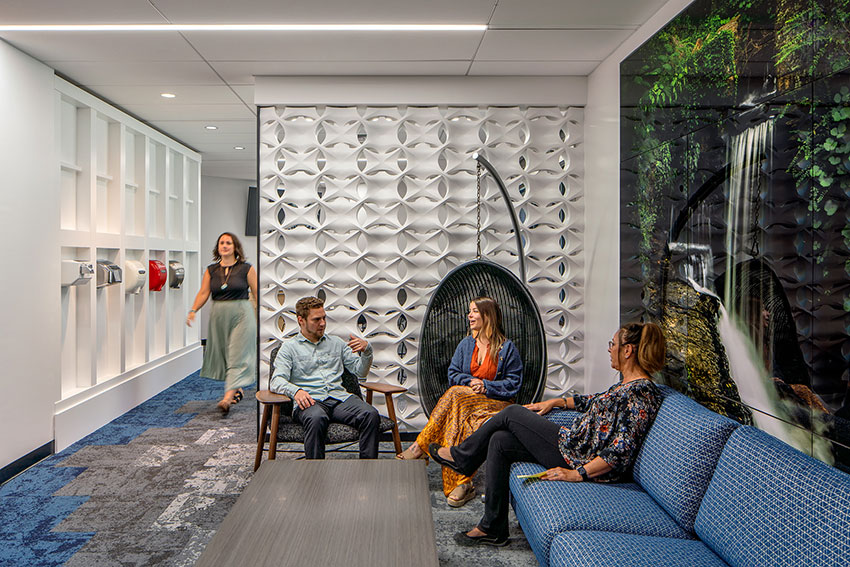
Photo courtesy of Excel Dryer
Images of nature increase employee heath and welfare.
"Developed over 10 years and backed by the latest scientific research, WELL sets pathways for accomplishing health-first factors that help every one of us to do our best work and be our best selves by supporting our physical and mental health across 10 core concepts.
Rigorous performance standards for design interventions, operational protocols, and company-wide practices are verified by a third party." The WELL Building Standard was first launched in 2014, but research on it began in 2010. A two-year pilot phase of the second iteration of the WELL standard, WELL v2, premiered in 2018. The WELL v2 standard comprises 10 Concepts, within which are several Features. Some Features are mandatory for achieving WELL certification (called preconditions), and some are optional for earning more points (called optimizations).
The 10 Concepts of WELL are:
- Air
- Water
- Nourishment
- Light
- Movement
- Thermal Comfort
- Sound
- Materials
- Mind
- Community
Air Concept Intent: Aims to achieve high indoor air quality levels across a building's lifetime through diverse strategies, including source elimination or reduction, active and passive building design and operation strategies, and human behavior interventions.
Water Concept Intent: Covers aspects of the quality, distribution, and control of liquid water in a building. It includes features that address drinking water's availability and contaminant thresholds, as well as features targeting water management to avoid damage to building materials and environmental conditions.
Nourishment Concept Intent: Requires the availability of fruits and vegetables and nutritional transparency. It encourages the creation of food environments where the healthiest choice is the easiest choice.
Light Concept Intent: Promotes exposure to light and aims to create lighting environments that promote visual, mental, and biological health.
Movement Concept Intent: Promotes physical activity in everyday life through environmental design, policies, and programs to ensure that movement opportunities are integrated into the fabric of our culture, buildings, and communities.
Thermal Comfort Concept Intent: Aims to promote human productivity and provide maximum thermal comfort among all building users through improved HVAC system design and control and by meeting individual thermal preferences.
Sound Concept Intent: Aims to bolster occupant health and well-being by identifying and mitigating acoustical comfort parameters that shape occupant experiences in the built environment.
Materials Concept Intent: Aims to reduce human exposure, whether direct or through environmental contamination, to chemicals that may impact health during building construction, remodeling, furnishing, and operation.
Mind Concept Intent: Promotes mental health through policy, program, and design strategies that seek to address the diverse factors that influence cognitive and emotional well-being.
Community Concept Intent: Aims to support access to essential healthcare, build a culture of health that accommodates diverse population needs, and establish an inclusive, engaged occupant community.
How Building Certification Is Achieved: Building certification is achieved by earning a certain number of points. Certification can be achieved at the levels of Bronze (40 points, no minimum points per concept), Silver (50 points, minimum one point per concept), Gold (60 points, minimum two points per concept), and Platinum (80 points, minimum 3 points per concept). The complete Standard can be accessed online at www.v2.wellcertified.com.
According to WELL documents, certification requires several phases3:
Documentation and Tracking: Each project team must submit documentation of their efforts, which a third party evaluates. Documents are submitted directly within the project workspace and sent to the Green Business Certification Inc. (GBCI) for review. There are two rounds of documentation review: preliminary and final. If documentation is not approved during the initial review, the reviewer identifies areas that require adjustment. Projects should address the feedback and resubmit for a final review.
Verifying and Validating: WELL is a performance-based system. Therefore, every WELL project must be verified through onsite testing. These measurements determine various air and water quality parameters, as well as sound and light levels. The process differs from traditional building commissioning and assures that the space performs as intended, according to WELL requirements.
Performance Verification: An authorized WELL Performance Testing Agent completes this authorization. This professional typically spends one to three days in the building to validate the project's documentation and complete a series of performance tests, spot-checks, and measurements covering all WELL concepts. After certification, a physical onsite plaque can be ordered and installed to acknowledge the building's status as a certified healthy space.
Recertification: WELL Certification requires projects to monitor real-time building performance by collecting ongoing performance data. WELL-certified projects must undergo recertification every three years. The verification process for recertification is similar to certification, including documentation submission and performance verification for certain features.
WORKS WITH WELL OFFERS A DIRECTORY OF ALIGNED PRODUCTS
A directory of products that align with WELL values helps streamline the process of choosing products for projects seeking WELL certification.
As the Excel management and design team worked through the WELL certification process, they became aware of the Works with Well program, and Excel products are now listed. As stated by the standard: Works with WELL is a licensing program for manufacturers to serve the growing demand for healthy building solutions by demonstrating how their products fit into the WELL philosophy. This demonstrates leadership in an evolving landscape of ESG (environmental, social, and governance) priorities.
To get into the Works with Well program, manufacturers undergo a review and then confirm the alignment of their products with specific features in the WELL Standard. A customized QR code and product page on the WELL platform, along with a link to the manufacturer's website, aids specifiers in finding products compatible with WELL standards.
Accredited Professionals Like LEED, individuals can achieve the title of WELL Accredited Professional, or AP, to help guide projects through certification. This credential requires testing and completion of annual continuing education units. There are currently more than 23,000 WELL APs.
How WELL Aligns With LEED: An estimated 30 percent of WELL priorities overlap with LEED priorities. Teams can pursue the two certifications concurrently, and a collaboration between IWBI and USGBC has produced streamlined software to make documenting the two standards easier.
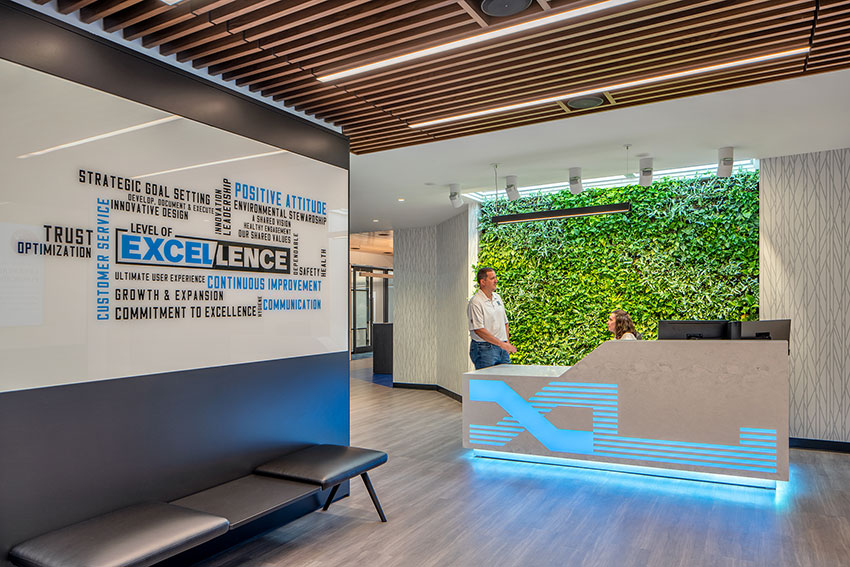
Photo courtesy of Excel Dryer
Custom-designed, illuminated, solid-surface reception desk that incorporates branding.
PROJECT FOCUS: FEATURES AND PRODUCTS HELPING EARN WELL CERTIFICATION
The renovation and addition of Excel Dryer's corporate campus involved scores of products and decisions to create a healthier workspace. A 360-degree video at the end of the course shows the entire project. These are some of the strategies pursued as Excel management and architect Katherine Brekka moved toward achieving WELL certification:
Living Walls
Of all the features in the new office space, the dual-sided living wall made of plants gets the most positive attention. The impact on occupants and visitors is visceral, with overhead skylights illuminating the lush green expanses. "We wanted to bring in natural materials to create a biophilic design inspired by nature," Brekka said, "bringing in plant life with a living wall to bring in as much direct connection to nature as well as indirect wherever possible."
WELL Concepts and Features–Mind
WELL Concept: Mind
WELL Feature: MO2 Nature and Place
Summary: Requires the integration of nature throughout the project and design strategies that celebrate the project's unique identity and inspire human delight.
Relevant LEED Credits
Designing with Nature, Biophilic Design for the Indoor Environment: Projects must implement a biophilic design plan that includes at least five distinct strategies related to biophilic design.
"In short, this office space makes me feel happy,” one employee said. “My favorite parts are the living walls in the conference room and behind the reception deck. Since two of the four walls of our conference room are glass, it allows all of us to enjoy that sensation of being close to nature all day. Because of that, I don’t have the feeling of being stuck inside. I actually feel good being in the office.”
Movable Glass Partition Wall
The movable glass wall provides many benefits. It allows views of the conference room's green living wall to radiate throughout the adjacent office space. Plus, it creates an expandable space to accommodate larger meetings and office functions. The glass is engineered for enhanced acoustical separation and heat management. According to Brekka: "The client's main goals for this project were to ensure that we had a flexible space. There are limitations on the site for future expansions here, so we wanted to make sure that we got this project right. We incorporated a flexible design. They also wanted to ensure that the space would foster collaboration and innovation to support the type of work that they do here."
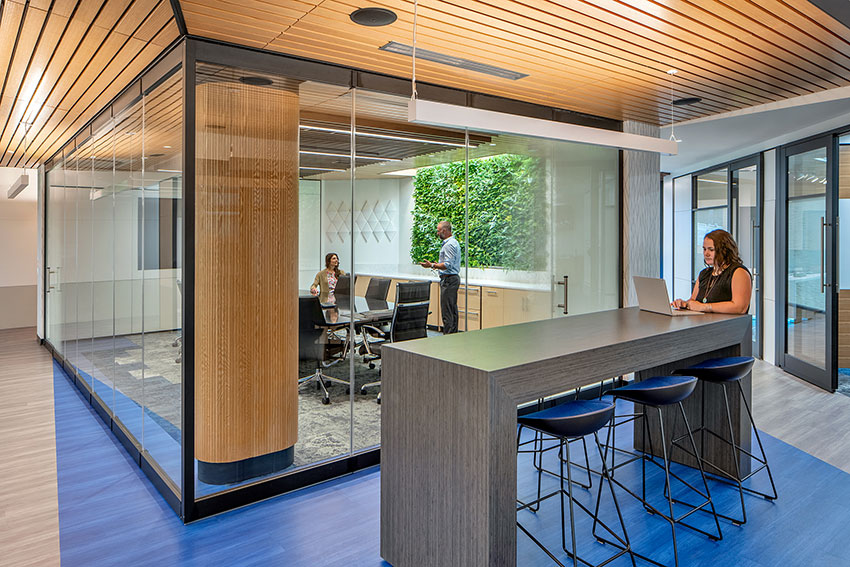
Photo courtesy of Excel Dryer
Sliding glass walls provide privacy in the conference area while still providing views of the living wall to employees and visitors.
WELL Concepts and Features–Mind
WELL Concept: Mind
WELL Feature: MO2 Nature and Place
Summary: This WELL feature requires the integration of nature throughout the project and design strategies that celebrate the project's unique identity and inspire human delight. The glass partition's transparency also contributes to precondition MO2.1, allowing direct sightlines to the green wall.
“I enjoy the conference room,” an employee said. “Not only can the green wall be seen through the glass partitions, but the partitions can be moved to open up the space for more people, or they can be closed for sound privacy as needed.”
Air Purification with UV Radiation and MERV 13 Filters
For Gagnon, a primary goal for the space was to prioritize the health and wellness of occupants. Because of the pandemic and growing awareness of airborne pathogens, the quality and cleanliness of the office air were critically important. "Researchers have stated that people spend 80 to 90 percent of their lives indoors," Gagnon explained, "so the challenge, especially post-COVID-19, is to make the indoor environment, especially the air quality, as healthy as possible for people."
Architect Brekka used her knowledge and research to find solutions that impressed the company's employees. "To prioritize the health and wellness of occupants in this space, we looked closely at what we could do to improve the indoor air quality," Brekka said.
"Within the HVAC system, we included UV radiation. The UVGI (ultraviolet germicidal irradiation) lamps kill airborne pathogens, including COVID-19 in a single pass. We also included high media filtration Merv 13 filters with an activated charcoal layer to remove VOCs. We focused on getting the best air quality we could within the space."
WELL Concepts and Features–Air
WELL Concept: Air
WELL Feature: A13 Enhanced Supply Air
Summary: Requires that the projects use supply air that is not recirculated or that is treated with carbon fibers, media filters, and/or Ultraviolet Germicidal Irradiation (UVGI).
Well Feature: A14 Microbe and Mold Control
Summary: Requires projects to utilize UVGI systems and/or conduct regular inspections on cooling system components to reduce or eliminate the growth of microbes and mold.
According to one employee, “Coming back to the office after working from home was a big change. The owners put a lot of effort into making the space feel safe for the employees. Since the pandemic, air quality has been top of mind for most people. The products implemented by the owners to enhance air quality made us feel comfortable coming back to the office."
Advanced Lighting Controls
During the renovation planning, the team gave extra attention to the quality of light inside the building. The space now enjoys abundant natural light, and the electric lighting plays a big part in creating a space that people want to be in. "Other strategies we used to reinforce a healthy interior was looking at energy, efficient LED lighting that is a tunable white system," Brekka explained. That means the light changes color temperature and intensity throughout the day to align with natural daylight patterns to reinforce and support our natural circadian rhythms. "This essentially makes it easier to focus and be productive during the day and ensures that you get a better restful night's sleep, which has so many health benefits," she said.
WELL Concepts and Features–Light
WELL Concept: Light
WELL Feature: L08 Electric Light Quality
Summary: Requires projects to provide lights that emit a high quality of light and do not display signs of flicker.
Relevant LEED Credits
Interior Lighting: Requires projects to promote occupants' productivity, comfort, and well-being by providing high-quality lighting.
"There are so many benefits I've noticed working in this new office space,” an employee noted. “The biggest one to me is the lighting system. The controls mimic natural outdoor light, changing with our circadian rhythms throughout the day. So it helps me stay fresh and awake in the morning, and coordinates with my circadian rhythm throughout the day to keep me productive."
Shades and Light Shelves
The new office was organized strategically to give all employee workspaces a view of the exterior while allowing the entry of controlled daylight. Light shelves reflect natural light up to the ceiling and then back down to the floor and into the building's interior. Shades help control direct sunlight during certain parts of the day.
WELL Concepts and Features–Light
WELL Concept: Light
WELL Feature: L05 Daylight Design Strategies
Summary: Requires projects to design spaces to integrate daylight into indoor environments so that daylight may be used for visual tasks along with electric lighting. It also provides individuals with a connection to outdoor spaces through windows. It also allows up to two points for integrating solar shading.
Solid Surface Reception Desk
The designer worked with a high-end fabricator to custom design the GREENGUARD-certified solid-surface desk to help avoid off-gassing VOCs that would defeat the goal of a workspace with clean and healthy air. The result is a beautiful desk utilizing a transparent solid surface and LED lighting to introduce branding and make it seem like it's “floating on Excel Blue Air.”
WELL Concepts and Features–Materials
WELL Concept: Materials
WELL Feature: X06 VOC Restrictions
Summary: Aims to reduce human exposure, whether direct or through environmental contamination, to chemicals that may impact health during the construction, remodeling, furnishing, and operation of buildings.
Relevant LEED Credits
Low-Emitting Materials: Projects must use materials on the building interior that meet the low-emitting criteria for at least two product categories (ex. ≥ 75% of all furniture costs)
Indoor Environmental Quality Performance: Based on measurements of carbon dioxide and total volatile organic compounds (TVOC). The GREENGUARD-certified desk limits introducing pollutants (VOCs) into the air.
Ergonomic Furniture/Bullpen
The ergonomic furniture and the bullpen desk configuration ensure the incorporation of the most sustainable materials. The ergonomic design promotes physical well-being, enhanced productivity, and higher workplace satisfaction.
WELL Concepts and Features–Materials, Movement, Air
WELL Concept: Materials
WELL Feature: X05 Enhanced Materials Restrictions
Summary: Requires restricting chemicals found in products commonly installed in buildings.
WELL Concept: Movement
WELL Feature: V07 Active Furnishings
Summary: Requires projects to provide ample active workstations, such as a sit-stand or treadmill desk.
WELL Concept: Air
WELL Feature: A01 Air Quality
Summary: Requires projects to provide acceptable air quality levels, as determined by public health authorities.
Relevant LEED Credits:
Indoor Environmental Quality Performance: Based on measurements of carbon dioxide and total volatile organic compounds (TVOC). GREENGUARD-certified pieces limit the introduction of pollutants (VOCs) into the air.
Carpet and LVT Flooring
Woodgrain pattern LVT flooring and carpet tile from an environmentally responsible company cover the office floor. The carpet company recycles discarded fishing nets from the world's poorest coastal communities and repurposes them into new carpet fibers. The carpeting and luxury vinyl tile specified help move the project toward certification in two ways: absorbing unwanted sound and sourcing materials. The latter satisfied low VOC requirements as well as responsible sourcing.
WELL Concepts and Features–Sound, Materials
Well Concept: Sound
Well Feature: S05 Sound Reducing Surfaces
Summary: Requires the use of acoustic materials that absorb and/or block sound to support concentration and reduce reverberation.
WELL Concept: Materials
WELL Feature: X06 VOC Restrictions
Summary: Requires adherence to emission thresholds for materials placed inside the building envelope.
Relevant LEED Credits
Sourcing of Raw Materials: Projects must use products from various manufacturers that meet specific responsible sourcing and extraction criteria for at least 15 percent by cost of the total value of permanently installed building products in the project.
Sound Masking System & Acoustic Ceilings
A sound masking system included in the addition and renovation helps reduce distractions so that building occupants in an open space have more focus. "When dealing with an open plan layout, acoustics can be particularly challenging," Brekka noted.
Three main strategies create good acoustic design: Absorb noise, block noise, and cover noise. "We used high NRC-rated ceilings and carpets to help absorb unwanted noise levels," Brekka said. "We looked closely at the STC ratings, the sound transmission co-efficient, to ensure that we had proper speech privacy in the areas where Excel needed that to have a private conversation. For cover, we used a sound-masking system that creates a white noise engineered to be tuned to the frequency of human speech. It allows for better concentration in an open plan and less distraction."
WELL Concepts and Features–Sound
WELL Concept: Sound
WELL Feature: S06 Minimum Background Sound
Summary: Requires the use of dedicated artificial sound to increase speech privacy between occupied spaces uniformly.
Relevant LEED Credits
Acoustic Performance: Requires projects to implement best practices for acoustics, including minimizing HVAC background noise, meeting specific sound transmission requirements, or meeting specific reverberation requirements.
"What surprises me is how spacious the office is while maintaining low noise and a quiet feel,” an employee stated. “In the old office, there was less space and more people. When they opened up the space like this, I thought it would be loud and noisy. But the sound suppressing system and the white noise provide an environment conducive to focus. It really helps me avoid distractions throughout the day. I wasn’t expecting that benefit."
Integrated Sink Systems
One of the most important lessons we learned from the pandemic is the importance of proper hand hygiene for keeping us safe from viruses, bacteria, and pathogens that are transmitted by touch. Hand hygiene will always be top of mind post-pandemic and remain vital to staying healthy. The Excel renovations included a new innovation and design trend in the restrooms, integrated sink systems. An integrated sink system features their latest hand dryer mounted on the deck next to the faucet allows a person to wash, rinse, and dry all in one place and achieve proper hand hygiene. A system was also installed in the building's conference area reinforces the importance of hand hygiene and that it can be accomplished in areas other than the restroom.
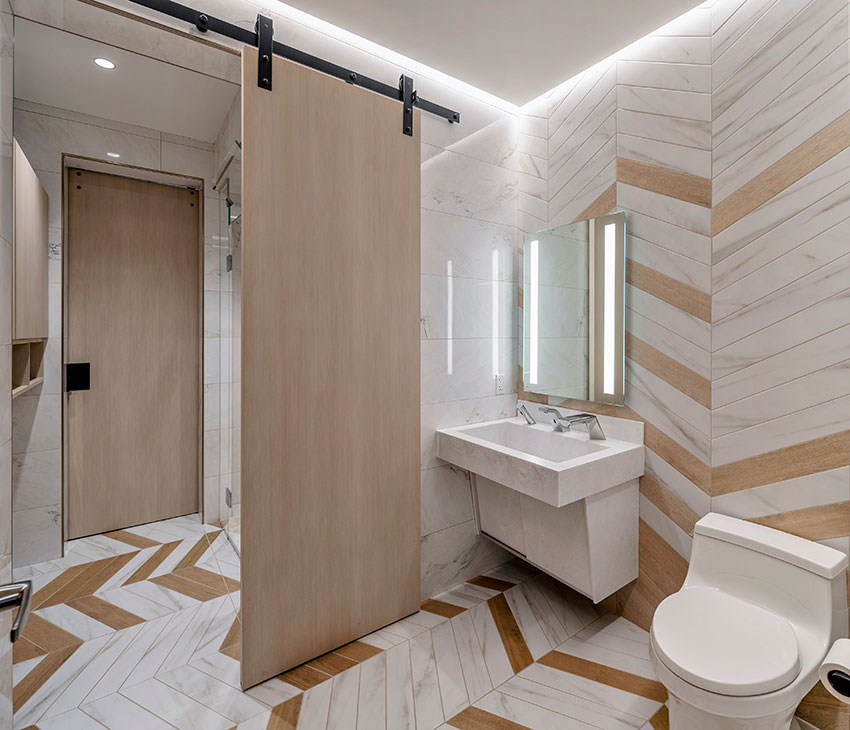
Photo courtesy of Excel Dryer
The integrated sink systems with touchless faucets, soap dispensers, and high-efficiency hand dryers contribute to hand hygiene and are featured in all restrooms, including this executive office restroom and the conference room.
WELL Concepts and Features–Water, Materials
WELL Concept: Water
WELL Feature: W08 Hygiene Support
Summary: Requires projects to provide bathrooms that accommodate users with diverse needs and to improve hygiene by offering large sinks, soap containers, hand drying support, and reduced touch points. For the Feature, hand dryers equipped with HEPA-compliant filters may be used for hand drying in non-healthcare WELL projects as an alternative to paper towels.4
WELL Concept: Materials
WELL Feature: X08 Materials Transparency
Summary: Requires the compilation and availability of product descriptions, with ingredients evaluated and disclosed through transparency programs.
"We looked for materials first that had the transparency documentation," Brekka recalled. "We could look at what is in the material with a product declaration or a declare label. One of the greatest resources we employed while searching for materials was the Mindful Materials Database. We also used the Sustainable Minds Transparency Catalog.5 Starting with that level of transparency is important to understand what's in this product."
Relevant LEED Credits
Indoor Water Use Reduction Prerequisite: Requires projects to install fixtures that meet specified water consumption requirements.
Indoor Water Use Reduction: Requires projects to further reduce fixtures and fitting water use from the calculated baseline.
Water Metering: Requires projects to install permanent water meters for indoor plumbing fixtures, including public lavatory (restroom) faucets.
Minimum Energy Performance Prerequisite: Requires projects to meet minimum energy use standards
Credit Optimize Energy Performance: Requires projects to lower their energy use further than baseline.
VIEW AND INTERACT WITH A 360-DEGREE VIEW OF THE EXCEL DRYER ADDITION AND RENOVATION
PRODUCT FOCUS: HOW HAND HYGIENE SUPPORTS A HEALTHY BUILDING AND HEALTHY PLANET
In the Excel Dryer project, integrated sink systems satisfy the most essential guidelines for hand hygiene. The three-part systems are touchless, meaning the faucet, soap dispenser, and high-speed, high-efficiency hand dryers all operate by sensors, eradicating the possibility of disease transmitted by touch.
In addition, the system allows users to complete the handwashing and hand-drying process in one spot, eliminating the need to travel around the restroom in search of paper towels. In fact, there are no paper towels at all.
The complete elimination of paper towels brings vast benefits to building occupants, maintenance personnel, building owners, and the planet:
- High-speed, high-efficiency hand dryers reduce the need for disposable paper towels which a recent Life Cycle Assessment (LCA) concluded can reduce a facility's carbon footprint by up to 94 percent.6 No trees are sacrificed to dry hands, and energy needs are minimal.
- Energy-efficient hand dryers are recognized for their green benefits and support LEED certification goals.
- WELL points can be earned by installing hand dryers with HEPA filtration as occupants have a hygienic hand drying solution.
- The specification of hand dryers reduces a facility’s labor and maintenance costs. No longer does the facility need to order, pay for, store, and dispose of paper waste.
This project has proven that renovating an office to achieve WELL certification by the International WELL Building Institute is crucial for enhancing the health and well-being of workplace occupants, setting a new standard in employee care that is becoming increasingly essential for future trends. The selection of appropriate products and materials is fundamental to the project's success, ensuring that the space not only meets stringent wellness criteria but also promotes a sustainable and productive environment.
"I believe we successfully achieved the project goal to promote occupant health and well-being, and embody the core values of Excel Dryer Inc. The integrated sink system was a perfect example of this, providing a beautiful, clean, and efficient design solution for handwashing," stated Katherine Brekka.
CONCLUSION
The COVID-19 pandemic and the WELL Building Standard are inextricably attached. With the rise of the pandemic came a parallel increased interest in healthy buildings. It was no longer a theory that a pandemic could stop society. The threat was real. Because research on the WELL standard for healthy buildings had been going on for a decade, the standard was singularly prepared to lead the way.
In this course, we learned about the 10 Concepts of WELL: Air, Water, Nourishment, Light, Movement, Thermal Comfort, Sound, Materials, Mind, and Community. We learned about the importance of healthy buildings for occupants and how proper hand hygiene is paramount for all people and building types. Illustrating the certification process was a major remodel and addition to the Excel Dryer corporate headquarters. Such innovative products specified toward certification include living plant walls, air purification systems, lighting that mimics natural lighting, external or outside views from every workstation, low-VOC materials, sound masking, integrated sink systems featuring touchless, high-speed, high-efficiency hand dryers, and more. Going forward, based on the momentum of the WELL Building Standard, the spaces where we spend so much time will also help keep us healthy and safe.
END NOTES
1"Keeping Hands Clean." Centers for Disease Control and Prevention. Last Reviewed: 15 June 2022. Web: 11 March 2024. https://www.cdc.gov/hygiene/personal-hygiene/hands.html.
2Patrick, D.R.; Findon, C.; Miller, T.E. "Residual moisture determines the level of touch-contact-associated bacterial transfer following hand washing." Epidemiology & Infection. Cambridge University Press. 5 August 1997. Web: 11/3/2024. .
3"How does WELL Certification Work?" International WELL Building Institute. Web: 11 March 2024. .
4"Hygiene Support." Concepts/Water/Feature W08. International WELL Building Institute. Web: 11 March 2024. .
5"Sustainable Minds Transparency Catalog." Sustainable Minds. Web: 11 March 2024. .
6Freund, Julissa; Xue, Cher. “Comparative Life Cycle Assessment of Hand Drying Systems: Excel Hand Dryers and Paper Towel Systems”. True North Collective. May 2023. Web: 11 March 2024. .
Kathy Price-Robinson writes about building and design. Her remodeling series “Pardon Our Dust” ran for 12 years in the Los Angeles Times. She specializes in writing about buildings that are durable and resilient to climate disruptions, as well as products and designs that provide shade in hot climates. www.kathyprice.com





